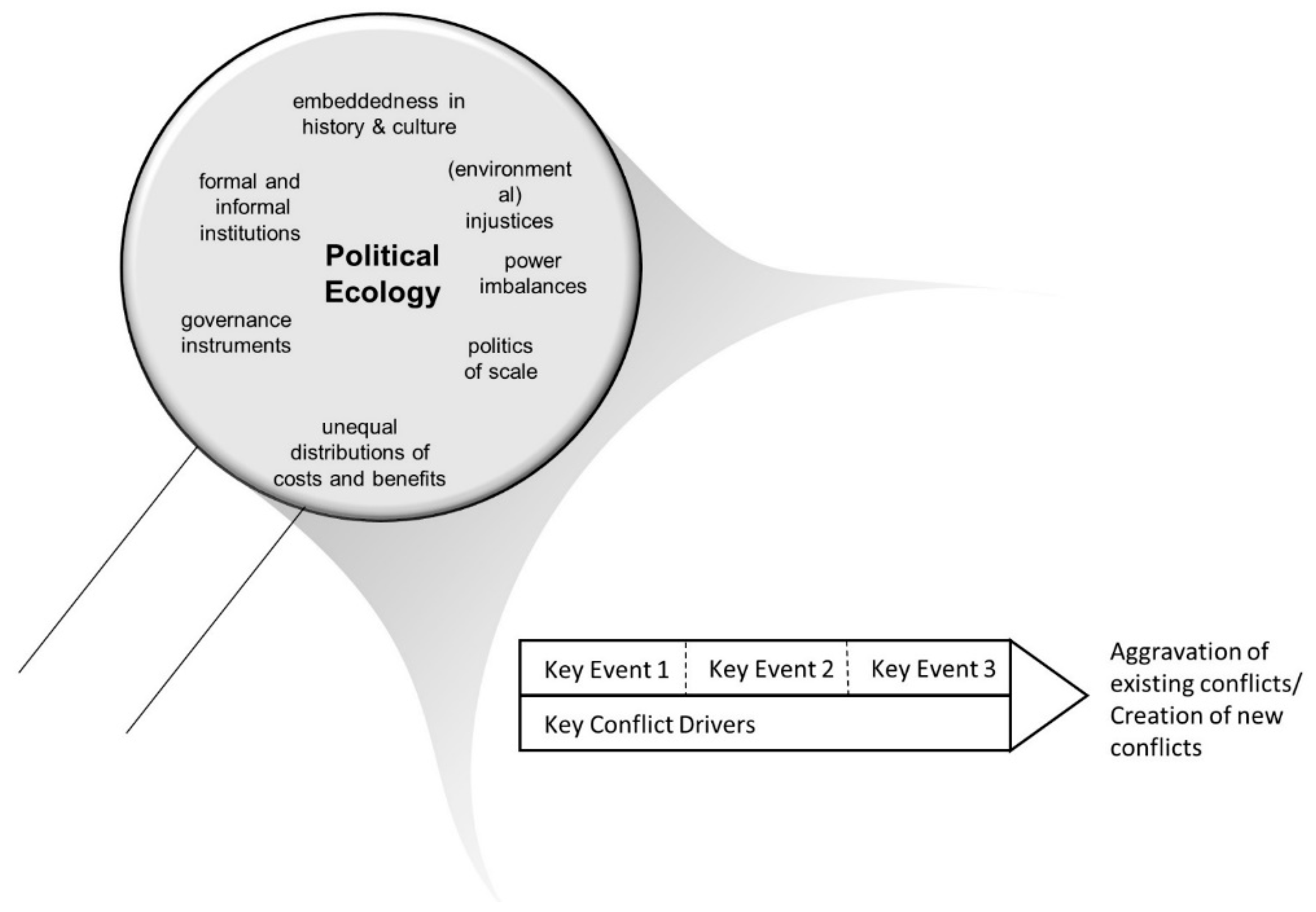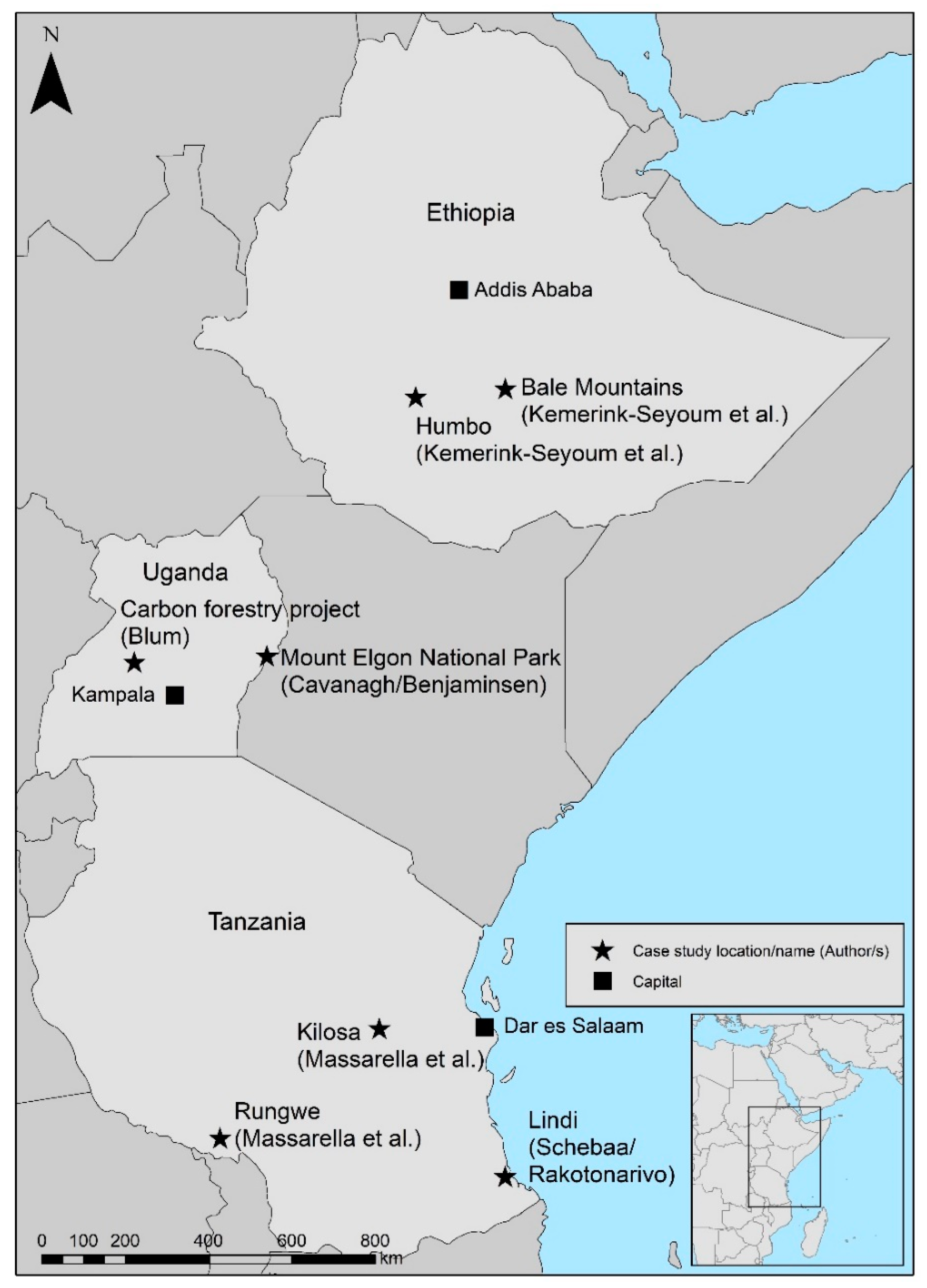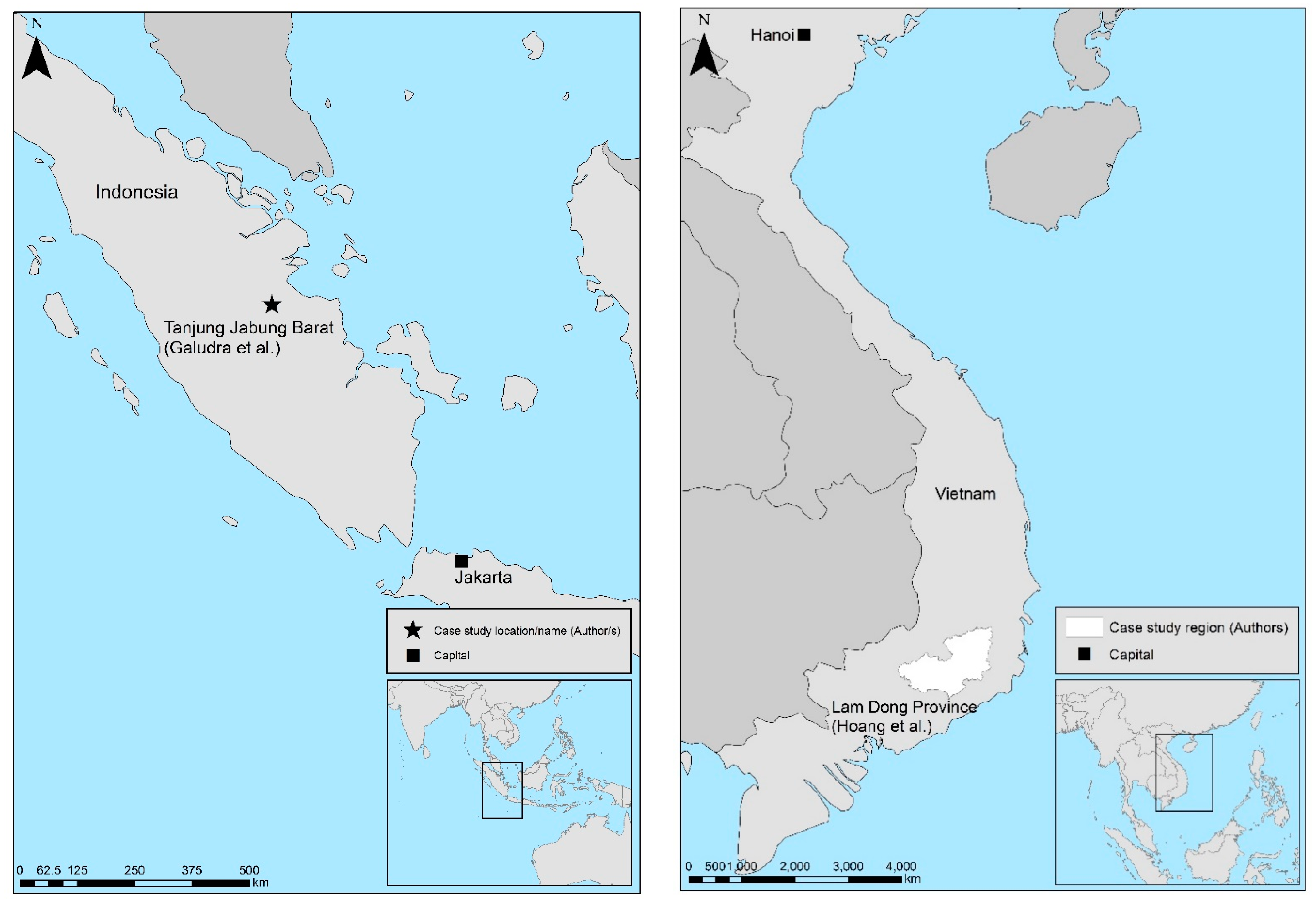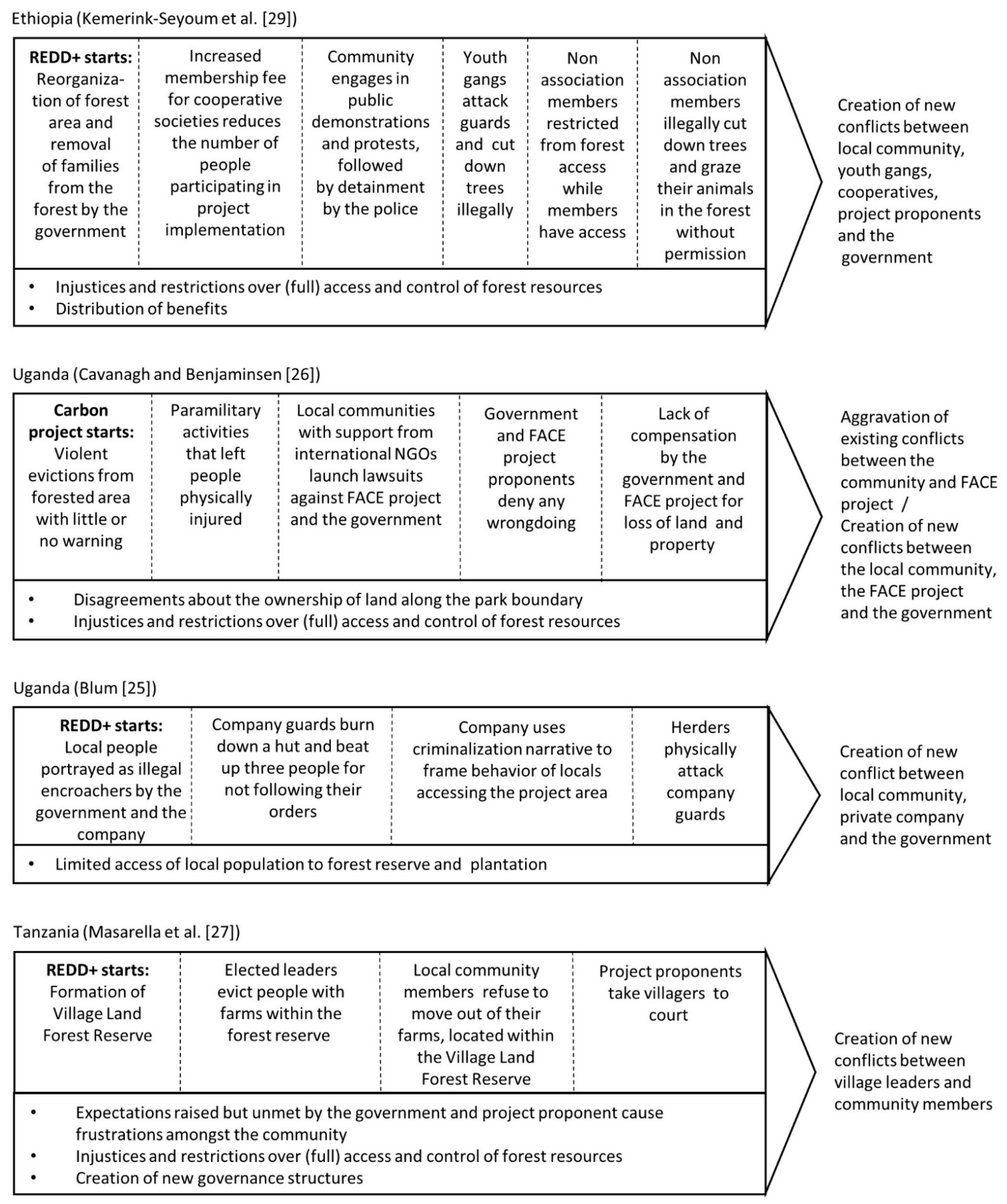REDD+ Conflict: Understanding the Pathways between Forest Projects and Social Conflict
Abstract
1. Introduction
2. Theoretical Framework
3. Materials and Methods
3.1. Selection of Cases
3.2. Overview of Cases
4. Results
4.1. Conflict Pathways
4.2. Effects of Conflict on Local Communities
4.3. Community Responses to Conflict
4.4. Conflict Mitigation Measures
5. Discussion
Author Contributions
Funding
Institutional Review Board Statement
Informed Consent Statement
Data Availability Statement
Acknowledgments
Conflicts of Interest
References
- Asiyanbi, A.; Lund, J. Policy persistence: REDD+ between stabilization and contestation. J. Political Ecol. 2020, 27, 378–400. [Google Scholar] [CrossRef]
- Watson, C.; Schalatek, L. The Global Climate Finance Architecture; Heinrich Böll Foundation: Washington, DC, USA, 2020. [Google Scholar]
- Wong, G.Y.; Luttrell, C.; Loft, L.; Yang, A.; Pham, T.T.; Naito, D.; Assembe-Mvondo, S.; Brockhaus, M. Narratives in REDD+ Benefit Sharing: Examining Evidence within and beyond the Forest Sector. Clim. Policy 2019, 19, 1038–1051. [Google Scholar] [CrossRef]
- Skutsch, M.; Turnhout, E. REDD+: If Communities are the Solution, What is the Problem? World Dev. 2020, 130, 1–9. [Google Scholar] [CrossRef]
- Asiyanbi, A.P.; Ogar, E.; Akintoye, O.A. Complexities and Surprises in Local Resistance to Neoliberal Conservation: Multiple Environmentalities, Technologies of the Self and the Poststructural Geography of Local Engagement with REDD+. Polit. Geogr. 2019, 69, 128–138. [Google Scholar] [CrossRef]
- Dunlop, T.; Corbera, E. Incentivizing REDD+: How Developing Countries are Laying the Groundwork for Benefit-sharing. Environ. Sci. Policy 2016, 63, 44–54. [Google Scholar] [CrossRef]
- Awono, A.; Somorin, O.A.; Eba’a Atyi, R.; Levang, P. Tenure and Participation in Local REDD+ Projects: Insights from Southern Cameroon. Environ. Sci. Policy 2014, 35, 76–86. [Google Scholar] [CrossRef]
- Pandit, R.; Neupane, P.R.; Wagle, B.H. Economics of Carbon Sequestration in Community Forests: Evidence from REDD+ Piloting in Nepal. J. For. Econ. 2017, 26, 9–29. [Google Scholar] [CrossRef]
- Maraseni, T.N.; Neupane, P.R.; Lopez-Casero, F.; Cadman, T. An Assessment of the Impacts of the REDD+ Pilot Project on Community Forests User Groups (CFUGs) and Their Community Forests in Nepal. J. Environ. Manag. 2014, 136, 37–46. [Google Scholar] [CrossRef]
- Andersson, K.P.; Smith, S.M.; Alston, L.J.; Duchelle, A.E.; Mwangi, E.; Larson, A.M.; de Sassi, C.; Sills, E.O.; Sunderlin, W.D.; Wong, G.Y. Wealth and the Distribution of Benefits from Tropical Forests: Implications for REDD+. Land Use Policy 2018, 72, 510–522. [Google Scholar] [CrossRef]
- Chomba, S.; Kariuki, J.; Lund, J.F.; Sinclair, F. Roots of Inequity: How the Implementation of REDD+ Reinforces Past Injustices. Land Use Policy 2016, 50, 202–213. [Google Scholar] [CrossRef]
- Samndong, R.; Vatn, A. Competing Tenures: Implications for REDD+ in the Democratic Republic of Congo. Forests 2018, 9, 662. [Google Scholar] [CrossRef]
- Kansanga, M.M.; Luginaah, I. Agrarian Livelihoods under Siege: Carbon Forestry, Tenure Constraints and the Rise of Capitalist Forest Enclosures in Ghana. World Dev. 2019, 113, 131–142. [Google Scholar] [CrossRef]
- Cavanagh, C.J.; Vedeld, P.O.; Trædal, L.T. Securitizing REDD+? Problematizing the Emerging Illegal Timber Trade and Forest Carbon Interface in East Africa. Geoforum 2015, 60, 72–82. [Google Scholar] [CrossRef]
- Bayrak, M.M.; Marafa, L.M. Ten Years of REDD+: A Critical Review of the Impact of REDD+ on Forest-dependent Communities. Sustainability 2016, 8, 620. [Google Scholar] [CrossRef]
- Froese, R.; Schilling, J. The Nexus of Climate Change, Land Use, and Conflicts. Curr. Clim. Chang. Rep. 2019, 5, 24–35. [Google Scholar] [CrossRef]
- Scheffran, J.; Link, P.M.; Schilling, J. Theories and Models of Climate-Security Interaction: Framework and Application to a Climate Hot Spot in North Africa. In Climate Change, Human Security and Violent Conflict: Challenges for Societal Stability; Scheffran, J., Brzoska, M., Brauch, H.G., Link, P.M., Schilling, J., Eds.; Hexagon Series on Human and Environment Security and Peace; Springer: Berlin, Germany, 2012; Volume 8, pp. 91–131. [Google Scholar]
- Seter, H.; Theisen, O.M.; Schilling, J. All about Water and Land? Resource-Related Conflicts in East and West Africa Revisited. GeoJournal 2018, 83, 169–187. [Google Scholar] [CrossRef]
- Schilling, J.; Schilling-Vacaflor, A.; Flemmer, R.; Froese, R. A Political Ecology Perspective on Resource Extraction and Human Security in Kenya, Bolivia and Peru. Extr. Ind. Soc. 2020, 1–12. [Google Scholar] [CrossRef]
- Turner, M.D. Political Ecology and the Moral Dimensions of “Resource Conflicts”: The Case of Farmer-Herder Conflicts in the Sahel. Political Geogr. 2004, 23, 863–889. [Google Scholar] [CrossRef]
- Watts, M. Political Ecology. In A Companion to Economic Geography; Sheppard, E., Barnes, T., Eds.; Blackwell: London, UK, 2000; pp. 257–274. [Google Scholar]
- Schilling, J.; Saulich, C.; Engwicht, N. Introduction: A Local to Global Perspective on Resource Governance and Conflict. Confl. Secur. Dev. 2018, 18, 433–461. [Google Scholar] [CrossRef]
- Ide, T.; Lopez, M.R.; Fröhlich, C.; Scheffran, J. Pathways to Water Conflict during Drought in the MENA Region. J. Peace Res. 2021, 58, 568–582. [Google Scholar] [CrossRef]
- Eisenhardt, K.M.; Graebner, M.E. Theory Building from Cases: Opportunities and Challenges. Acad. Manag. J. 2007, 50, 25–32. [Google Scholar] [CrossRef]
- Blum, M. Whose Climate? Whose Forest? Power Struggles in a Contested Carbon Forestry Project in Uganda. For. Policy Econ. 2020, 115, 102137. [Google Scholar] [CrossRef]
- Cavanagh, C.; Benjaminsen, T.A. Virtual Nature, Violent Accumulation: The ‘Spectacular Failure’ of Carbon Offsetting at a Ugandan National Park. Geoforum 2014, 56, 55–65. [Google Scholar] [CrossRef]
- Massarella, K.; Sallu, S.M.; Ensor, J.E.; Marchant, R. REDD+, Hype, Hope and Disappointment: The Dynamics of Expectations in Conservation and Development Pilot Projects. World Dev. 2018, 109, 375–385. [Google Scholar] [CrossRef]
- Scheba, A. Market-Based Conservation for Better Livelihoods? The Promises and Fallacies of REDD+ in Tanzania. Land 2018, 7, 119. [Google Scholar] [CrossRef]
- Kemerink-Seyoum, J.S.; Tadesse, T.M.; Mersha, W.K.; Duker, A.E.C.; De Fraiture, C. Sharing Benefits or Fueling Conflicts? The Elusive Quest for Organizational Blue-prints in Climate Financed Forestry Projects in Ethiopia. Glob. Environ. Chang. 2018, 53, 265–272. [Google Scholar] [CrossRef]
- Galudra, G.; van Noordwijk, M.; Agung, P.; Suyanto, S.; Pradhan, U. Migrants, Land Markets and Carbon Emissions in Jambi, Indonesia: Land Tenure Change and the Prospect of Emission Reduction. Mitig. Adapt. Strateg. Glob. Chang. 2013, 19, 715–731. [Google Scholar] [CrossRef][Green Version]
- Holmes, I.; Potvin, C.; Coomes, O. Early REDD+ Implementation: The Journey of an Indigenous Community in Eastern Panama. Forests 2017, 8, 67. [Google Scholar] [CrossRef]
- Hoang, C.; Satyal, P.; Corbera, E. ‘This is my Garden’: Justice Claims and Struggles over Forests in Vietnam’s REDD+. Clim. Policy 2018, 19, S23–S35. [Google Scholar] [CrossRef]
- Sanders, A.J.P.; Hyldmo, H.D.; Prasti, H.R.D.; Ford, R.M.; Larson, A.M.; Keenan, R.J. Guinea Pig or Pioneer: Translating Global Environmental Objectives Through to Local Actions in Central Kalimantan, Indonesia’s REDD+ Pilot Province. Glob. Environ. Change-Hum. Policy Dimens. 2017, 42, 68–81. [Google Scholar] [CrossRef]
- Milne, S.; Mahanty, S. Value and Bureaucratic Violence in the Green Economy. Geoforum 2019, 98, 133–143. [Google Scholar] [CrossRef]
- Pasgaard, M. Lost in translation? How Project Actors Shape REDD+ Policy and Outcomes in Cambodia. Asia Pac. Viewp. 2015, 56, 111–127. [Google Scholar] [CrossRef]
- Lounela, A. Contested Values and Climate Change Mitigation in Central Kalimantan, Indonesia. Soc. Anthropol. 2020, 28, 862–880. [Google Scholar] [CrossRef]
- Scheba, A.; Rakotonarivo, O.S. Territorialising REDD plus: Conflicts over Market-based Forest Conservation in Lindi, Tanzania. Land Use Policy 2016, 57, 625–637. [Google Scholar] [CrossRef]
- Luttrell, C.; Loft, L.; Fernanda Gebara, M.; Kweka, D.; Brockhaus, M.; Angelsen, A.; Sunderlin, W.D. Who Should Benefit from REDD+? Rationales and Realities. Ecol. Soc. 2013, 18, 1–18. [Google Scholar] [CrossRef]
- McDermott, M.; Mahanty, S.; Schreckenberg, K. Examining Equity: A Multidimensional Framework for Assessing Equity in Payments for Ecosystem Services. Environ. Sci. Policy 2013, 33, 416–427. [Google Scholar] [CrossRef]
- Holmes, I.; Potvin, C. Avoiding Re-inventing the Wheel in a People-centered Approach to REDD+. Conserv. Biol. 2014, 28, 1380–1393. [Google Scholar] [CrossRef]
- Agrawal, A.; Nepstad, D.; Chhatre, A. Reducing Emissions from Deforestation and Forest Degradation. Annu. Rev. Environ. Resour. 2011, 36, 373–396. [Google Scholar] [CrossRef]
- Ribot, J.; Larson, A.M. Reducing REDD Risks: Affirmative Policy on an Uneven Playing Field. Int. J. Commons 2012, 6, 233–254. [Google Scholar] [CrossRef]
- Oyono, P.R.; Ribot, J.C.; Larson, A. Green and Black Gold in Rural Cameroon: Natural Resources for Local Governance, Justice and Sustainability; Food and Agriculture Organization of the United Nations: Rome, Italy, 2006; Volume 22. [Google Scholar]
- Sikor, T.; Nguyen, T.Q. Why May Forest Devolution Not Benefit the Rural Poor? Forest Entitlements in Vietnam’s Central Highlands. World Dev. 2007, 35, 2010–2025. [Google Scholar] [CrossRef]
- Larson, A.M.; Soto, F. Decentralization of Natural Resource Governance Regimes. Annu. Rev. Environ. Resour. 2008, 33, 213–239. [Google Scholar] [CrossRef]
- Schreckenberg, K.; Luttrell, C. Participatory Forest Management: A Route to Poverty Reduction? Int. For. Rev. 2009, 11, 221–238. [Google Scholar] [CrossRef]
- Bluffstone, R.; Robinson, E.; Guthiga, P. REDD+ and Community-Controlled Forests in Low-Income Countries: Any Hope for a linkage? Ecol. Econ. 2013, 87, 43–52. [Google Scholar] [CrossRef]
- Awung, N.S.; Marchant, R. Quantifying Local Community Voices in the Decision-making Process: Insights from the Mount Cameroon National Park REDD+ Project. Environ. Sociol. 2018, 4, 235–252. [Google Scholar] [CrossRef]
- Sills, E.; Atmadja, S.; Sassi, C.d.; Duchelle, A.E.; Kweka, D.; Resosudarmo, I.A.P.; Sunderlin, W. REDD+ on the Ground: A Case Book of Subnational Initiatives Across the Globe; CIFOR: Bogor, Indonesia, 2014. [Google Scholar]
- Sunderlin, W.D.; Larson, A.M.; Duchelle, A.E.; Resosudarmo, I.A.P.; Huynh, T.B.; Awono, A.; Dokken, T. How are REDD+ Proponents Addressing Tenure Problems? Evidence from Brazil, Cameroon, Tanzania, Indonesia, and Vietnam. World Dev. 2014, 55, 37–52. [Google Scholar] [CrossRef]
- Dokken, T.; Caplow, S.; Angelsen, A.; Sunderlin, W. Tenure Issues in REDD+ Pilot Project Sites in Tanzania. Forests 2014, 5, 234–255. [Google Scholar] [CrossRef]
- Peters, E.P. Inequality and Social Conflict Over Land in Africa. J. Agrar. Chang. 2004, 4, 269–314. [Google Scholar] [CrossRef]
- Lund, C. Local Politics and the Dynamics of Property in Africa; Cambridge University Press: Cambridge, UK, 2008. [Google Scholar]
- Peluso, N.L.; Vandergeest, P. Political Ecologies of War and Forests: Counterinsurgencies and the Making of National Natures. Ann. Assoc. Am. Geogr. 2011, 101, 587–608. [Google Scholar] [CrossRef]
- Cotula, L.; Mayers, J. Tenure in REDD: Start-Point or Afterthought; IIED: London, UK, 2009. [Google Scholar]
- Larson, A.M. Forest Tenure Reform in the Age of Climate Change: Lessons for REDD+. Glob. Environ. Chang. 2011, 21, 540–549. [Google Scholar] [CrossRef]
- Naughton-Treves, L.; Wendland, K. Land Tenure and Tropical Forest Carbon Management. World Dev. 2014, 55, 1–6. [Google Scholar] [CrossRef]
- Corbera, E.; Estrada, M.; May, P.; Navarro, G.; Pacheco, P. Rights to Land, Forests and Carbon in REDD+: Insights from Mexico, Brazil and Costa Rica. Forests 2011, 2, 301–342. [Google Scholar] [CrossRef]
- Duchelle, A.E.; Cromberg, M.; Gebara, M.F.; Guerra, R.; Melo, T.; Larson, A.; Cronkleton, P.; Börner, J.; Sills, E.; Wunder, S.; et al. Linking Forest Tenure Reform, Environmental Compliance, and Incentives: Lessons from REDD+ Initiatives in the Brazilian Amazon. World Dev. 2014, 55, 53–67. [Google Scholar] [CrossRef]
- Murdiyarso, D.; Brockhaus, M.; Sunderlin, W.D.; Verchot, L. Some Lessons Learned from the First Generation of REDD+ Activities. Curr. Opin. Environ. Sustain. 2012, 4, 678–685. [Google Scholar] [CrossRef]
- Phelps, J.; Webb, E.L.; Agrawal, A. Land Use-Does REDD+ Threaten to Recentralize Forest Governance? Science 2010, 328, 312–313. [Google Scholar] [CrossRef] [PubMed]
- Sandbrook, C.; Nelson, F.; Adams, W.M.; Agrawal, A. Carbon, Forests and the REDD Paradox. Oryx 2010, 44, 330–334. [Google Scholar] [CrossRef]
- Hayes, T.; Persha, L. Nesting Local Forestry Initiatives: Revisiting Community Forest Management in a REDD+ World. For. Policy Econ. 2010, 12, 545–553. [Google Scholar] [CrossRef]
- Cronkleton, P.; Bray, D.B.; Medina, G. Community Forest Management and the Emergence of Multi-Scale Governance Institutions: Lessons for REDD+ Development from Mexico, Brazil and Bolivia. Forests 2011, 2, 451–473. [Google Scholar] [CrossRef]
- Adhikari, S.; Kingi, T.; Ganesh, S. Incentives for Community Participation in the Governance and Management of Common Property Resources: The Case of Community Forest Management in Nepal. For Policy Econ 2014, 44, 1–9. [Google Scholar] [CrossRef]
- UN. U.N. Report of the Conference of the Parties on its Sixteenth Session, Held in Cancun from 29 November to 10 December 2010. Available online: https://www.google.com/url?sa=t&rct=j&q=&esrc=s&source=web&cd=&ved=2ahUKEwiEstrMpcnwAhVF2qQKHfySB8YQFjAAegQIBhAD&url=https%3A%2F%2Funfccc.int%2Fresource%2Fdocs%2F2010%2Fcop16%2Feng%2F07a01.pdf&usg=AOvVaw36AirtEfa7AMHGXVZzKMNj (accessed on 14 May 2021).
- Kemp, D.; Owen, J.R. Corporate Readiness and the Human Rights Risks of Applying FPIC in the Global Mining Industry. Bus. Hum. Rights J. 2017, 2, 163–169. [Google Scholar] [CrossRef]
Short Biography of Authors






| Thematic Focus | REDD+ (Carbon Offset) |
|---|---|
| Level of detail | High enough to retrace the conflict pathway |
| Method | Field research |
| Publication | Peer-reviewed journal article |
| Country (Authors) | Effects of Conflict on Local Communities | Communities’ Response |
|---|---|---|
| Ethiopia (Kemerink-Seyoum et al. [29]) | Loss of
|
|
| Uganda (Cavanagh and Benjaminsen [26]) | Loss of
|
|
| Uganda (Blum [25]) | Loss of
|
|
| Tanzania (Masarella et al. [27]) | Loss of
|
|
| Tanzania (Scheba and Rakotonarivo [37]) |
|
|
| Vietnam (Hoang et. al. [32]) | Loss of
|
|
| Indonesia (Galudra et. al. [30]) | Loss of
|
|
| Panama (Holmes et al. [31]) | Loss of
|
|
| Country (Authors) | Conflict Mitigation Measures |
|---|---|
| Ethiopia (Kemerink-Seyoum et al. [29]) | Court ruled in favour of farmers as legal tenants of land, and they should be allowed to return to it. Forest cooperative’s unilateral decision to pay cash to its members under the pretext of micro-credit services. |
| Uganda (Cavanagh and Benjaminsen [26]) | Project subjected to a series of independent examinations by one of the world’s largest and most respected audit firms. Favourable consent judgment that recognised the community as the ‘‘historical and indigenous’’ inhabitants of the Mount Elgon Forest. Further evictions and destruction of property stopped by the court. |
| Uganda (Blum [25]) | Regular meetings between government and local community to clarify land titles. Changes in the enforcement policy from a strict one-to-one dialogue. Collaborative livelihood support programmes established. Dismissal/reduction of the number of forest guards. Grievance procedure to investigate conflict claims was carried out by a carbon market consultant. Company stopped tree planting on 1000 ha. of land, contested by neighbouring farmers. Matter forwarded to NFA to seek clarity about its owners. Depending on the age of planted trees, the company tolerates cattle grazing within the reserve. Company built six boreholes and 15 valley dams close to the project area for the farmers to freely access water. Access to restricted area regulated by formal protocol. Collaborative monitoring with local leaders. Company emphasizes peaceful co-existence between “good neighbours”, as well as attracting enough rain for the future. |
| Tanzania (Masarella et al. [27]) | No mitigation measures implemented, |
| Tanzania (Scheba and Rakotonarivo [37]) | New forest governance developed and implemented. Equal payment scheme created. Legitimate land boundaries developed. Integrated land-use planning exercises discussed, mapped, and documented. |
| Vietnam (Hoang et. al. [32]) | No mitigation measures noted. |
| Indonesia (Galudra et. al. [30]) | New land-use plan developed. Villagers co-manage a private rubber plantation company. Benefit-sharing of rubber plantation under negotiation. |
| Panama (Holmes et al. [31]) | Formation of Advisory Council on Conflict Resolution and REDD+. |
Publisher’s Note: MDPI stays neutral with regard to jurisdictional claims in published maps and institutional affiliations. |
© 2021 by the authors. Licensee MDPI, Basel, Switzerland. This article is an open access article distributed under the terms and conditions of the Creative Commons Attribution (CC BY) license (https://creativecommons.org/licenses/by/4.0/).
Share and Cite
Alusiola, R.A.; Schilling, J.; Klär, P. REDD+ Conflict: Understanding the Pathways between Forest Projects and Social Conflict. Forests 2021, 12, 748. https://doi.org/10.3390/f12060748
Alusiola RA, Schilling J, Klär P. REDD+ Conflict: Understanding the Pathways between Forest Projects and Social Conflict. Forests. 2021; 12(6):748. https://doi.org/10.3390/f12060748
Chicago/Turabian StyleAlusiola, Rowan Alumasa, Janpeter Schilling, and Paul Klär. 2021. "REDD+ Conflict: Understanding the Pathways between Forest Projects and Social Conflict" Forests 12, no. 6: 748. https://doi.org/10.3390/f12060748
APA StyleAlusiola, R. A., Schilling, J., & Klär, P. (2021). REDD+ Conflict: Understanding the Pathways between Forest Projects and Social Conflict. Forests, 12(6), 748. https://doi.org/10.3390/f12060748





